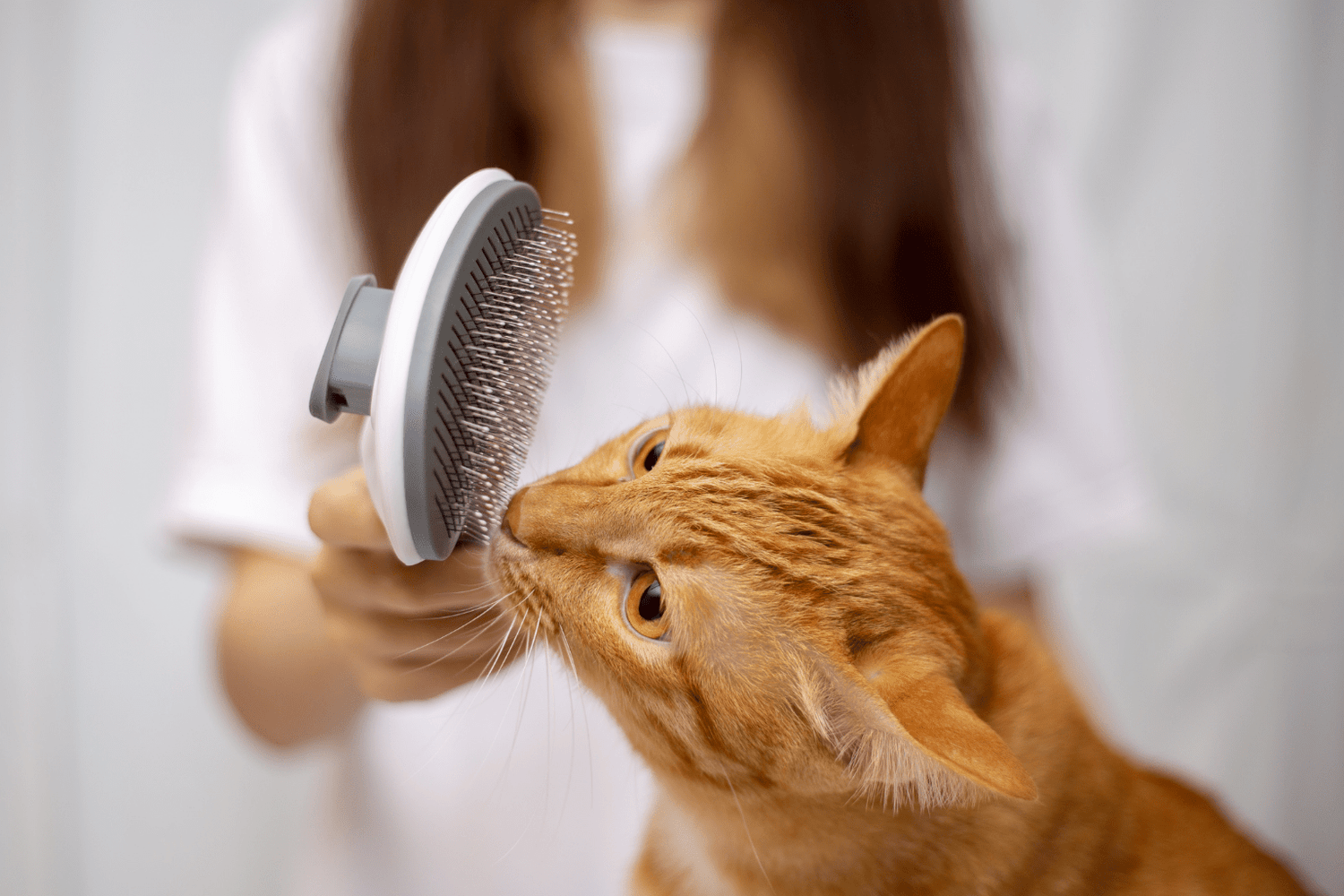Key Takeaways
- Cat hair loss, or alopecia, can indicate an underlying disease rather than normal shedding.
- Normal shedding differs significantly from disease-related hair loss in pattern and severity.
- Recognizing the signs of disease hair loss is important for timely intervention and care.
- Gentle natural remedies can support a healthier coat and alleviate hair loss symptoms.
Table of Contents
- Is Your Cat's Hair Loss Normal or a Sign of Disease?
- Why Do Cats Lose Hair? (Main Causes Explained for Pet Parents)
- How to Identify the True Cause of Your Cat's Hair Loss
- Gentle Support for Cat Alopecia: Natural Remedies and Everyday Care
- Spotting and Interpreting Symptoms: What Alopecia Looks (and Feels) Like
- Top 5 Causes Compared: Allergies vs. Parasites vs. Infections vs. Hormones vs. Stress
- How Vets Diagnose Hair Loss: Tests, Timelines, and What to Expect
- Recovery Timeline: What to Expect as Your Cat's Fur Grows Back
- Prevention: Keeping Your Cat's Coat Healthy for Life
- When to Seek Help: Red-Flag Symptoms and Vet-Visit Triggers
- Key Takeaways for Hopeful Cat Parents
Cat Hair Loss (Alopecia): Causes, Symptoms, and Gentle Natural Support for a Healthier Coat
Is Your Cat's Hair Loss Normal or a Sign of Disease?
Every cat parent knows the daily dance of lint rollers and vacuum cleaners, but when does normal shedding cross into concerning territory? Cat disease hair loss, medically called alopecia, creates distinct patterns that differ dramatically from seasonal coat changes.
Normal shedding spreads evenly across your cat's body, increasing during spring and fall transitions. You'll find loose fur on furniture and clothing, but your cat's skin remains healthy underneath. Disease-related hair loss creates bald patches – circular spots, symmetrical thinning, or areas where your cat obsessively licks until raw. For cats experiencing hair loss, skin irritation, or mange, a targeted bundle can help address multiple causes at once.
Gentle natural remedies can support a healthier coat and alleviate hair loss symptoms, especially when used alongside veterinary care for underlying conditions.
Red Flag Check: If you can see your cat's skin through missing fur, notice redness or sores, or catch them frantically grooming the same spot repeatedly, it's time to investigate further.
Why Do Cats Lose Hair? (Main Causes Explained for Pet Parents)

Understanding the root cause transforms a worrying mystery into a manageable health concern. Parasites top the list – fleas, mites, and lice create intense itching that leads to scratching-induced bald spots, typically behind the ears and along the tail base. A broad spectrum cat dewormer remedy can help eliminate internal parasites that contribute to hair loss.
Allergies manifest differently, creating symmetrical hair loss patterns on both sides of your cat's body. Food sensitivities often target the face and neck, while environmental allergens affect the belly and inner thighs. Thyroid hair loss in cats presents as gradual, non-itchy thinning, especially common in senior cats experiencing hormonal changes.
Stress-induced over-grooming creates smooth, bald patches where your cat's rough tongue removes fur faster than it can regrow. Indoor cats facing household changes, new pets, or disrupted routines frequently develop this behavioral pattern.
How to Identify the True Cause of Your Cat's Hair Loss
Transform yourself into a pet detective with systematic observation. Start by photographing affected areas weekly – this visual timeline helps track progression and recovery. Part your cat's fur gently to examine the skin underneath, looking for flakes, redness, or tiny moving specks that indicate parasites.
Create a simple log noting when hair loss occurs, which body parts are affected, and any accompanying behaviors. Does your cat scratch frantically after meals (potential food allergy) or during thunderstorms (stress response)? These patterns provide crucial diagnostic clues. Cat allergy relief and immune support remedies can help manage symptoms caused by environmental or food allergies.
Use a fine-toothed comb to collect samples of loose fur and debris – your veterinarian can examine these for parasites or fungal elements that aren't visible to the naked eye. For more information on identifying parasites, you might find this article on does my cat have worms helpful.
Gentle Support for Cat Alopecia: Natural Remedies and Everyday Care
While identifying the underlying cause remains essential, gentle support can ease your cat's discomfort and promote healing. Homeopathic pellets offer chemical-free relief that works with your cat's natural healing processes rather than suppressing symptoms with harsh medications.
BestLife4Pets' carefully formulated pellets dissolve easily in your cat's mouth, requiring no wrestling with droppers or liquid medications that stress both cats and parents. These tasteless remedies support skin healing and may reduce the obsessive licking that worsens cat disease hair loss. For cats whose hair loss is triggered by stress or anxiety, a calming and immune support bundle can be especially beneficial.

Complement natural remedies with stress-reduction techniques: maintain consistent feeding schedules, create quiet retreat spaces, and engage in gentle play sessions that redirect anxious energy into healthy activity.
Spotting and Interpreting Symptoms: What Alopecia Looks (and Feels) Like

Recognizing the visual and tactile signs of cat disease hair loss helps you respond quickly and appropriately. Patchy baldness appears as distinct circular or oval areas where fur is completely absent, often accompanied by changes in skin texture or color underneath.
Scaly, flaky skin suggests fungal infections or severe dryness, while red, inflamed patches typically indicate allergic reactions or bacterial complications. Thyroid hair loss in cats presents differently – gradual, symmetrical thinning without irritation, creating a "moth-eaten" appearance across the coat. For more on common health issues in aging cats, see aging cat common health issues.
Examination Tip: Gently stroke your cat's fur backward to reveal the skin beneath. Healthy skin appears pink or pale, while problematic areas show redness, bumps, or unusual odors that warrant veterinary attention.
Watch for behavioral changes alongside physical symptoms. Cats experiencing itchy conditions scratch frantically, while those with hormonal hair loss remain comfortable and continue normal grooming patterns.
Top 5 Causes Compared: Allergies vs. Parasites vs. Infections vs. Hormones vs. Stress
Each major cause of feline alopecia creates distinct patterns that help narrow down the underlying problem. Parasitic infestations develop rapidly, creating intense itching and hair loss concentrated around the ears, neck, and tail base where fleas and mites prefer to feed. A mange and ear mite remedy can help address these specific causes of hair loss.
| Cause | Onset Speed | Typical Location | Key Symptoms | Itch Level |
|---|---|---|---|---|
| Parasites | Days to weeks | Ears, neck, tail base | Visible scratching, black specks | Severe |
| Allergies | Weeks to months | Face, belly, symmetrical | Red skin, seasonal patterns | Moderate to severe |
| Infections | Days to weeks | Circular patches | Scaling, odor, spreading | Mild to moderate |
| Hormones | Months | Gradual, even thinning | No irritation, older cats | None |
| Stress | Weeks | Accessible areas (belly, legs) | Over-grooming, smooth patches | None (behavioral) |
Hormonal causes like thyroid dysfunction progress slowly over months, affecting senior cats with gradual, non-irritating fur loss. Stress-induced over-grooming targets easily reached body parts, creating perfectly smooth bald patches where your cat's tongue has methodically removed every hair.
How Vets Diagnose Hair Loss: Tests, Timelines, and What to Expect
Veterinary diagnosis begins with a thorough physical examination, where your vet examines affected areas under magnification and takes detailed notes about pattern, distribution, and skin condition. Skin scrapings and fur samples provide immediate insights, with results available within minutes for parasite identification. For a deeper look at how veterinarians approach alopecia, see this comprehensive guide to alopecia diagnosis in cats.
More complex cases may require fungal cultures (7-14 days for results) or blood panels to check thyroid function and rule out systemic diseases. Bringing photos of your cat's condition progression, along with notes about behavioral changes, significantly speeds the diagnostic process.
Preparation Checklist: Document when hair loss started, photograph affected areas weekly, list any recent household changes, and note your cat's appetite and energy levels to help your vet connect the dots faster.
Recovery Timeline: What to Expect as Your Cat's Fur Grows Back

Hair regrowth follows a predictable pattern once the underlying cause receives appropriate treatment. New fur typically appears as fine fuzz within 2-4 weeks, gradually thickening over the following months as hair follicles recover their normal growth cycle.
Complete coat restoration varies by cause and individual cat health. Parasite-related cat disease hair loss often shows dramatic improvement within 6-8 weeks, while hormonal conditions may require 3-6 months for full recovery. Stress-induced over-grooming can resolve quickly once environmental triggers are addressed, though some cats need ongoing behavioral support. For additional support, consider the cat skin & allergy bundle to help with shedding, dandruff, and coat restoration.
Track progress with weekly photos and gentle palpation of previously affected areas. New hair often grows back slightly different in texture or color initially, normalizing as follicles fully heal and resume regular production cycles.
Prevention: Keeping Your Cat's Coat Healthy for Life
Proactive coat care prevents many common causes of feline hair loss. Regular flea prevention eliminates the most frequent trigger, while consistent grooming sessions help you spot early changes before they become problematic.
Maintain stable household routines to minimize stress-related over-grooming. Provide multiple hiding spots, consistent meal times, and gradual introductions for any household changes. Quality nutrition supports healthy skin and fur growth, with adequate protein and moisture content forming the foundation of coat health. For more tips on keeping your cat healthy, see 7 tips for preventing kidney disease in cats.
When to Seek Help: Red-Flag Symptoms and Vet-Visit Triggers
Certain symptoms require immediate veterinary attention. Open sores, bleeding, or oozing lesions signal potential bacterial infections that need prescription treatment. Sudden, extensive hair loss paired with lethargy, appetite changes, or excessive thirst may indicate serious conditions like thyroid hair loss in cats or other hormonal imbalances.
Don't Wait If You See: Rapid spreading of bald patches, skin that feels hot to the touch, foul odors from affected areas, or your cat showing signs of pain when touched.
Prepare for your vet visit by documenting the progression with photos and notes about your cat's behavior changes. Bring a list of any products you've tried and your cat's complete dietary history. This preparation helps your veterinarian diagnose the underlying cause of cat disease hair loss more efficiently. For further reading on causes and treatments, see this authoritative resource on cat hair loss.
Remember that early intervention often leads to faster recovery and prevents secondary complications from developing.
Key Takeaways for Hopeful Cat Parents

Hair loss in cats is a symptom, not a life sentence. Most cases of cat disease hair loss respond well to appropriate care when the underlying cause is identified and addressed consistently. Whether dealing with allergies, stress, or hormonal imbalances, cats have remarkable healing capacity when supported properly.
The combination of veterinary diagnosis and gentle, natural support creates the best outcomes. BestLife4Pets understands that every cat deserves compassionate care without harsh side effects. Our sugar-free pellets provide targeted support while respecting your cat's sensitive system.
Trust your instincts as a pet parent, you know your cat better than anyone. Document changes, seek professional guidance when needed, and remember that with patience and the right approach, most cats return to their beautiful, healthy coats.
Your dedication to your cat's wellbeing makes all the difference in their recovery journey.
Not a substitute for professional veterinary advice.
Frequently Asked Questions
Why is my cat suddenly losing her hair?
Sudden hair loss in cats can signal an underlying issue like allergies, parasites, infections, hormonal imbalances, or stress. Unlike normal shedding, disease-related hair loss often appears as bald patches or areas your cat over-grooms. Identifying the cause helps guide gentle natural support and timely veterinary care to promote a healthier coat.



